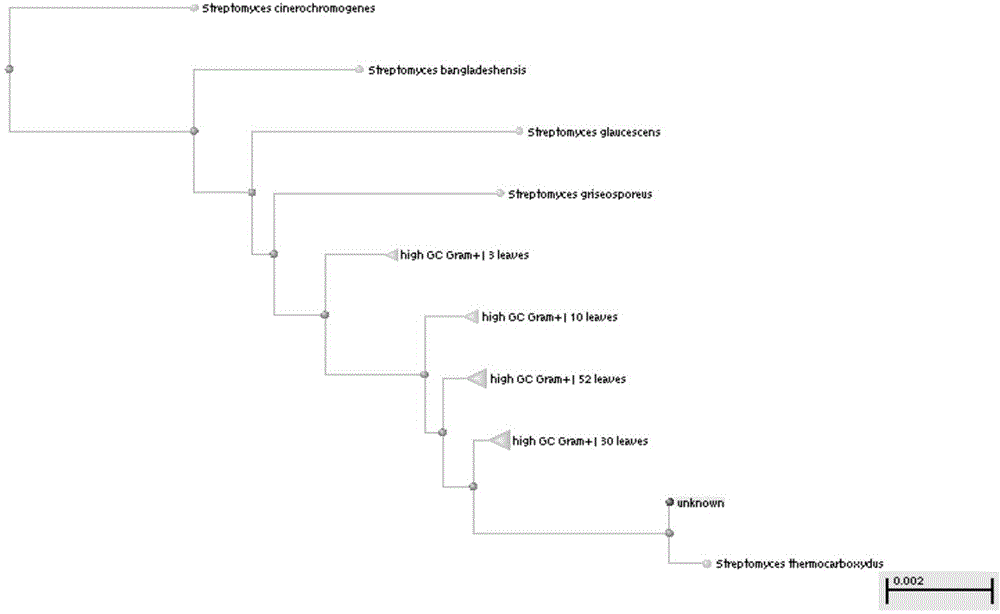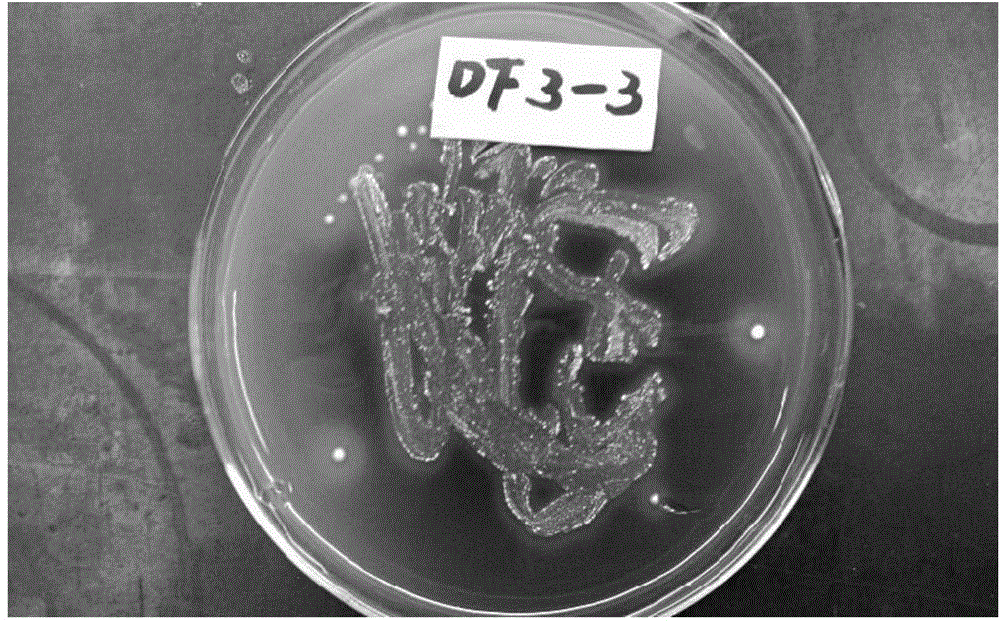Thermophilic carbon monoxide streptomycete low-temperature subspecies Dstr3-3 and application thereof
A technology of carbon monoxide and streptomyces, applied in the direction of application, bacteria, biochemical equipment and methods, etc., can solve the problems of complex composting process of garden waste
- Summary
- Abstract
- Description
- Claims
- Application Information
AI Technical Summary
Problems solved by technology
Method used
Image
Examples
Embodiment 1
[0065] Embodiment 1, Streptomyces thermophilic carbon monoxide strain Dstr3-3 of the present invention
[0066] One, the isolation and purification of the bacterial strain Dstr3-3
[0067] Using Gao's No. 1 medium as the isolation medium, the Dstr3-3 strain was isolated and purified from the garden waste compost of Beijing Agricultural College by the dilution plate separation method. The specific steps are as follows:
[0068] Take litter compost to make a suspension, and under aseptic conditions, use a 10ml sterile pipette to draw 10ml of water sample and place it in the first bottle of 90ml sterile water, rinse the pipette three times, and shake it by hand Break up the granular samples in 10 minutes. Take 0.5ml of bacterial liquid and inoculate in beef extract peptone medium, Gao's No. 1 medium, and guaiacol-PDA medium, inoculate 9 plates each, and place them upside down in an incubator at 30°C, 50°C, or 60°C for 3-15 days , and observe the result. Various cultured microo...
Embodiment 2
[0098] Embodiment 2, effect verification of strain Dstr3-3 decomposing lignin ability
[0099] 1. Preliminary screening of lignin decomposition ability
[0100] Selection medium: Guaiacol medium
[0101] When the actinomycete Dstr3-3 was cultured in the guaiacol medium, it produced a discoloration reaction, and it was preliminarily determined that the bacteria had the ability to degrade lignin ( image 3 ).
[0102] 2. Determination of ligninase type
[0103] On the edge of the colonies of two identical plate culture medium, use a hole puncher to make several small holes with a diameter of about 5 mm, and drop a few drops of H 2 o 2 and the mixed solution of pyrol and 0.1mol / L α-naphthol, under the condition of constant temperature environment, observe the size of the color-changing circle at the edge of the colony.
[0104] By using the punching method, a few drops of H were added to the edge of the colony of Dstr3-3 and the color-changing plug respectively. 2 o 2 and ...
Embodiment 3
[0105] Embodiment 3, bacterial strain Dstr3-3 is used for the effect verification of garden waste composting
[0106] In this experiment, garden waste such as dead branches and leaves in the suburbs of Beijing was used as the main raw material, and different materials such as cow dung were added. At the same time, ventilation, water and different mixed strains were added. According to the orthogonal design, 4 factors and 4 levels of composting experiments were carried out to screen different composting materials. The influence of factors on the composting effect of garden waste, in order to provide a basis for the resource utilization of garden waste in the suburbs of Beijing.
[0107] 1 Materials and methods
[0108] 1.1 Materials
[0109] Composting materials: Garden waste was collected from the fall of 2012 autumn greening tree species on the campus of the tutoring unit Beijing Agricultural College; various animal manure was purchased from the surrounding villages of Beiji...
PUM
 Login to View More
Login to View More Abstract
Description
Claims
Application Information
 Login to View More
Login to View More - R&D
- Intellectual Property
- Life Sciences
- Materials
- Tech Scout
- Unparalleled Data Quality
- Higher Quality Content
- 60% Fewer Hallucinations
Browse by: Latest US Patents, China's latest patents, Technical Efficacy Thesaurus, Application Domain, Technology Topic, Popular Technical Reports.
© 2025 PatSnap. All rights reserved.Legal|Privacy policy|Modern Slavery Act Transparency Statement|Sitemap|About US| Contact US: help@patsnap.com



